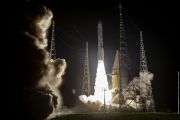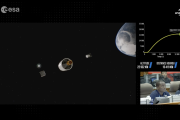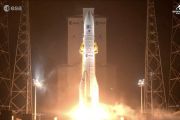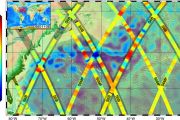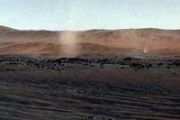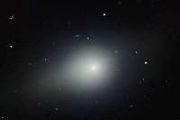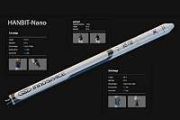
Copernical Team
Telescope Dismantled and Heading to New Mission in Chile
 At nearly 14,000 feet, Maunakea is the tallest mountain in Hawai'i, and the second tallest on any island on Earth. Clouds often settle below the mountain's barren, dark-brown summit, making the site one of the best for astronomy in the world.
At the summit, one can find several of the world's finest telescopes, including the W. M. Keck Observatory, a partnership between Caltech and the Uni
At nearly 14,000 feet, Maunakea is the tallest mountain in Hawai'i, and the second tallest on any island on Earth. Clouds often settle below the mountain's barren, dark-brown summit, making the site one of the best for astronomy in the world.
At the summit, one can find several of the world's finest telescopes, including the W. M. Keck Observatory, a partnership between Caltech and the Uni Helicity Space Raises $5M Seed Round for Fusion Propulsion Technology
 Helicity Space, a name that's beginning to resonate in the commercial space industry, recently heralded a significant advance in its quest to redefine space propulsion. The company has successfully secured a $5 million seed funding round, a move that not only underscores the industry's confidence in fusion technology but also marks a pivotal moment in space travel innovation.
This round of
Helicity Space, a name that's beginning to resonate in the commercial space industry, recently heralded a significant advance in its quest to redefine space propulsion. The company has successfully secured a $5 million seed funding round, a move that not only underscores the industry's confidence in fusion technology but also marks a pivotal moment in space travel innovation.
This round of NASA's Fermi Mission Creates 14-Year Time-Lapse of the Gamma-Ray Sky
 The cosmos comes alive in an all-sky time-lapse movie made from 14 years of data acquired by NASA's Fermi Gamma-ray Space Telescope. Our Sun, occasionally flaring into prominence, serenely traces a path through the sky against the backdrop of high-energy sources within our galaxy and beyond.
"The bright, steady gamma-ray glow of the Milky Way is punctuated by intense, days-long flares of n
The cosmos comes alive in an all-sky time-lapse movie made from 14 years of data acquired by NASA's Fermi Gamma-ray Space Telescope. Our Sun, occasionally flaring into prominence, serenely traces a path through the sky against the backdrop of high-energy sources within our galaxy and beyond.
"The bright, steady gamma-ray glow of the Milky Way is punctuated by intense, days-long flares of n Gaia's decade of discoveries: unravelling the intricacies of our galaxy
 Despite our many years spent observing the cosmos with ever-more powerful telescopes, there remains much to learn about the Milky Way. We cannot leave our galaxy to get a full outside view of its shape and properties, as we do when we study other galaxies. We are embedded within it, and so are limited to mapping the Milky Way from the inside out - and from a single vantage point.
At the st
Despite our many years spent observing the cosmos with ever-more powerful telescopes, there remains much to learn about the Milky Way. We cannot leave our galaxy to get a full outside view of its shape and properties, as we do when we study other galaxies. We are embedded within it, and so are limited to mapping the Milky Way from the inside out - and from a single vantage point.
At the st Cosmic lights in the forest
 Like a celestial beacon, distant quasars make the brightest light in the universe. They emit more light than our entire Milky Way galaxy. The light comes from matter ripped apart as it is swallowed by a supermassive black hole. Cosmological parameters are important numerical constraints astronomers use to trace the evolution of the entire universe billions of years after the Big Bang.
Quas
Like a celestial beacon, distant quasars make the brightest light in the universe. They emit more light than our entire Milky Way galaxy. The light comes from matter ripped apart as it is swallowed by a supermassive black hole. Cosmological parameters are important numerical constraints astronomers use to trace the evolution of the entire universe billions of years after the Big Bang.
Quas Astrophysicists publish Kepler Giant Planet Search, an aid to 'figure out where to find life'
 A team of astrophysicists led by Lauren Weiss, assistant professor in the Department of Physics and Astronomy at the University of Notre Dame, created the first-ever catalog of small, Earth-like planets with Jupiter-like siblings (planets that share the same star) - a critical component in the search for life elsewhere in our universe.
Forthcoming in the Astrophysical Journal, the Kepler G
A team of astrophysicists led by Lauren Weiss, assistant professor in the Department of Physics and Astronomy at the University of Notre Dame, created the first-ever catalog of small, Earth-like planets with Jupiter-like siblings (planets that share the same star) - a critical component in the search for life elsewhere in our universe.
Forthcoming in the Astrophysical Journal, the Kepler G The PI's Perspective: The Long Game
 New Horizons is healthy and speeding across the Kuiper Belt at a distance of over 5.5 billion miles from Earth!
The spacecraft is collecting round-the-clock data on our Sun's cocoon in the galaxy called the heliosphere, and transmitting that data as well as the final datasets from our flyby of Kuiper Belt object (KBO) Arrokoth, back to Earth.
The big news for New Horizons since I wro
New Horizons is healthy and speeding across the Kuiper Belt at a distance of over 5.5 billion miles from Earth!
The spacecraft is collecting round-the-clock data on our Sun's cocoon in the galaxy called the heliosphere, and transmitting that data as well as the final datasets from our flyby of Kuiper Belt object (KBO) Arrokoth, back to Earth.
The big news for New Horizons since I wro U.S. plans return to moon with an international astronaut by 2030
 The White House said Wednesday that the United States plans to land an international astronaut on the surface of the moon by 2030. Vice President Kamala Harris will announce the mission at Wednesday's Space Council meeting.
"The meeting will highlight the United States' extraordinary progress in broadening and deepening international space partnerships across a range of areas, including
The White House said Wednesday that the United States plans to land an international astronaut on the surface of the moon by 2030. Vice President Kamala Harris will announce the mission at Wednesday's Space Council meeting.
"The meeting will highlight the United States' extraordinary progress in broadening and deepening international space partnerships across a range of areas, including Sussex research takes us a step closer to sustaining human life on Mars
 Researchers at the University of Sussex have discovered the transformative potential of Martian nanomaterials, potentially opening the door to sustainable habitation on the red planet.
Using resources and techniques currently applied on the International Space Station and by NASA, Dr Conor Boland, a Lecturer in Materials Physics at the University of Sussex, led a research group that invest
Researchers at the University of Sussex have discovered the transformative potential of Martian nanomaterials, potentially opening the door to sustainable habitation on the red planet.
Using resources and techniques currently applied on the International Space Station and by NASA, Dr Conor Boland, a Lecturer in Materials Physics at the University of Sussex, led a research group that invest SpaceX and Intuitive Machines set revised launch window for IM-1 lunar mission
 Intuitive Machines, Inc. (Nasdaq: LUNR, LUNRW), in a recent announcement made in coordination with SpaceX, has set a new launch window for its much-anticipated IM-1 lunar mission. The mission, now targeting a multi-day window opening in mid-February 2024, has been rescheduled due to shifts in the SpaceX launch manifest, primarily caused by unfavorable weather conditions.
The IM-1 mission i
Intuitive Machines, Inc. (Nasdaq: LUNR, LUNRW), in a recent announcement made in coordination with SpaceX, has set a new launch window for its much-anticipated IM-1 lunar mission. The mission, now targeting a multi-day window opening in mid-February 2024, has been rescheduled due to shifts in the SpaceX launch manifest, primarily caused by unfavorable weather conditions.
The IM-1 mission i 
